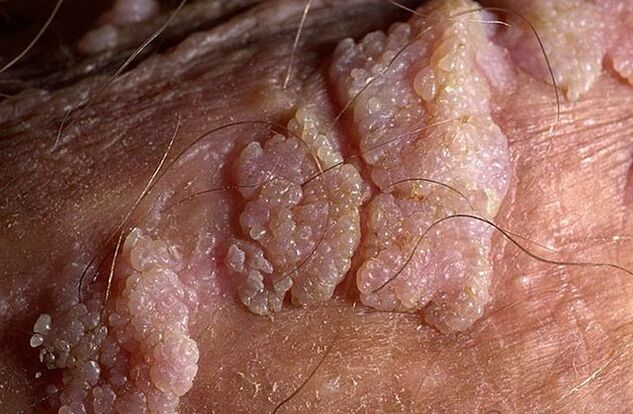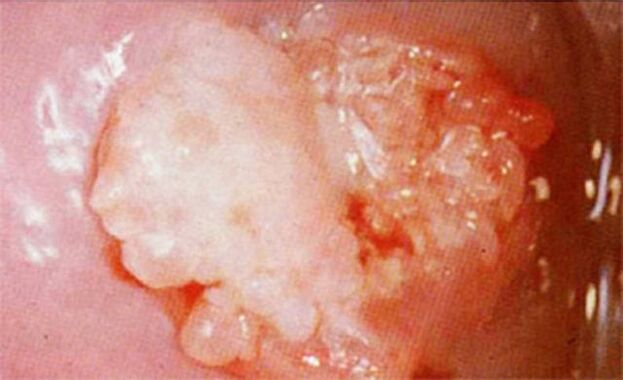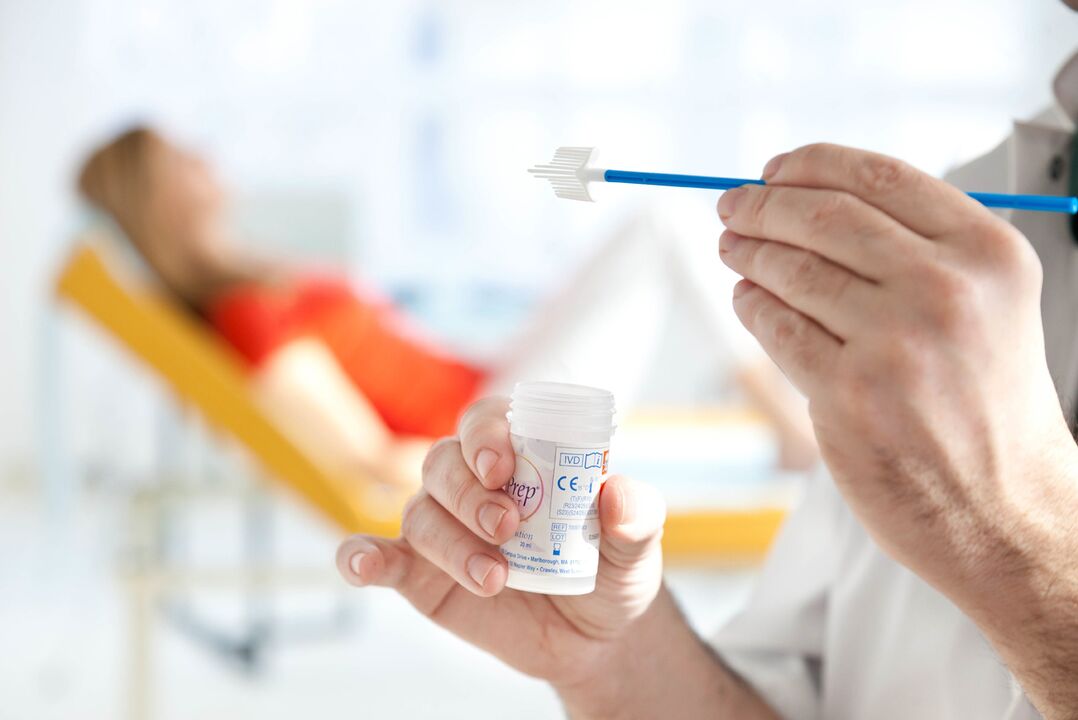Concern in the genital area is the appearance of cone-shaped flesh-colored growths, which is fully justified, since the health of the genital area is an important point for the general physical and moral well-being of a person.
These growths of warts cause discomfort, interfere with normal sex life and can also cause more serious health problems. If the integrity of the condylomas is damaged, an infection may occur and a transition to a malignant formation may occur. Therefore, the desire to get rid of such manifestations is understandable and quite natural.
Reasons for submission
The cause of papilloma warts is the human papilloma virus. This virus contains a specific set of DNA that successfully integrates into the cells of the human body and causes them to change their developmental cycle, shape and structure.

According to the international classification of diseases ICD-10, the human papillomavirus is coded B97. 7. Anogenital warts of a venereal nature are assigned the code A63. 0.
There are many different types of this virus, each of which causes specific wart papillomas. The type of virus determines the course of the pathological process, symptoms, location of manifestation and severity of complications.
Types are divided into two main types:
- skin, with predominant appearance in the skin layer;
- mucosa, which appear in the mucous epithelium of the genital organs, oral cavity, etc.
In addition, papillomavirus types differ depending on the risk of degeneration into an oncogenic process into oncogenic, moderately oncogenic and non-oncogenic.
More often, several different types are present in the body of an infected person at the same time.
Routes of infection and risk factors
There are several ways for the pathogen to enter the body:
- "Vertical" transmission.. This is the name of the transfer of an infectious agent from mother to child during pregnancy. Currently, it is not known whether the infection occurs in the prenatal period or directly during childbirth, but it is undesirable to perform a cesarean section on a mother with papillomavirus. Caesarean section is selected only in the case of papillomas with bleeding inside the birth canal.
- The sexual way.The infectious agent can enter the body during vaginal, oral or anal sex. The pathogen is also transmitted through saliva during kissing. Using a condom during sex does not guarantee protection against the virus, but it does make it less likely to be transmitted.
- The home way.This mechanism of disease transmission is quite rare. Infection can occur through contact with the patient's personal belongings. Since the virus is contained in saliva and urine, it is possible to get infected by using someone else's dishes, shared towels, personal hygiene items, from the edge of the toilet or in a bathroom.
The mode of infection is determined mainly by the age of the person: in babies, with a high degree of certainty, it can be established that the infection came from the mother, and for older children, through contact and family contact. From the age of 17, sexual transmission occurs in most cases.
According to statistics, the human papillomavirus is present in the bodies of more than half of the sexually mature population, but in most cases it does not manifest itself in any way and is present in the form of a carriage.
The peak of the disease occurs at young ages from 17 to 25 years old. This is due to maximum sexual activity and the high sensitivity of the epithelium in the organs of the genitourinary system.
Predisposing factors that increase the likelihood of the disease are:
- early onset of sexual activity;
- frequent change of sexual partners;
- age up to 25 years;
- sexual contact with people who previously had human papillomavirus or other sexually transmitted diseases;
- pregnancy;
- imbalance of intravaginal flora;
- any chronic disease;
- endometriosis;
- therapy with cytostatic drugs or glucocorticosteroids;
- excess weight;
- disruption of the thyroid gland and cessation of insulin production;
- hypovitaminosis.
Frequent stress and non-compliance with the principles of personal hygiene greatly increase a person's chances that, after entering the body, the infection will enter the active phase.

After entry, the virus spreads throughout the body through the bloodstream, attaches to cells, penetrates their structure and integrates its DNA into the cell's DNA. The affected cells then begin to grow and divide actively, due to which condylomas appear.
Ways of development
After entering the human body, the virus does not cause any symptoms for a certain period of time.
The course of the disease occurs according to the following algorithm:
- Hidden period. During this stage, the carrier is not aware of the presence of an infectious pathogen, as there are no clinical manifestations. However, at this stage a person is already contagious and can infect their partner through sexual contact. This latent period can last from 2-3 months to several years.
- The onset of the disease occurs when the virus multiplies sufficiently in the body or when the protective mechanisms of the immune system decrease. During this period the first symptoms appear.
- Active development with increasing symptoms.
The further course of events is developing in one of the following directions:
- self-healing with the complete disappearance of papilloma warts (most often observed after the end of pregnancy);
- slow flow and lack of growth of skin eruptions;
- active dynamics of papillomas with an increase in shape, size, number and merging of closely located groups;
- degeneration of benign to malignant growths.
Types of condylomas
There are several conventional types of condyloma papillomas:
- exophytic- protruding above the surface of the skin or mucous membrane with preferential growth from the outside;
- endophytic- with a predominant growth deep in the skin structures, therefore little visible during visual inspection;
- Buschke-Levenshtein education- characterized by rapid growth rates, large sizes and frequent relapses after a course of treatment. With this form, external growth and damage to the deep internal layers of tissue occur.

Genital warts can have a thin base or wide in shape. If the stem is thin, the tip may be pointed or stick-like. Broad-based papillomas are quite rare. The color of all such discharges is close to the color of the skin: from flesh to pink. The surface can be smooth or covered with a layer of keratin.
Warts can appear individually or in groups resembling nodules. Sometimes such multiple groups reach the size of 1. 5 cm. When several groups come together, formations appear that resemble cauliflower florets or a rooster's comb. These growths make it easy to identify the disease after examination.
Single increments usually do not cause as much concern as large elements. In rare cases, they break and bleed a little.
Large formations are more problematic: they can soak, bleed and worsen due to a secondary infection that takes root in the affected areas.
Symptoms
The first symptoms appear after the end of the latent period, which in the shortest case lasts a few weeks.
The appearance of condylomas occurs as follows:
- slight rash appears on the skin, which begins to itch;
- a rash appears on the skin or mucous surface in the form of bubbles or small bumps;
- tubercles grow gradually to 1-1. 5 centimeters in length;
- New rashes appear nearby, which also turn into condyloma papules.
Localization depends on the specific strain and the place of entry of the pathogen into the body:
- external genitalia;
- anal area (anogenital papilloma);
- inside the urethra;
- in the cervix;
- in the epithelium in the mouth (on the buccal surfaces, on the tongue and inside the lips).

The clinical framework may vary in each specific case depending on the health status of the person. For small warts, no other symptoms can be observed.
With a more severe course, the following accompanying symptoms are observed:
- itching or burning at the site of the rash;
- sensation of a foreign object in the perineal area;
- moisture in the area of neoplasms;
- unpleasant smell from the area where the warts are located.
With physical activity, long walks or running, all the above symptoms intensify.
In severe cases, fatigue, weakness, signs of intoxication, prolonged headache, fever and high temperature are observed.
In men and women, the symptoms have some differences. This is due to anatomical differences and characteristics of sexual behavior.
Manifestations in men
Condylomas in men most often affect the scrotum, groin, pubis and various structural parts of the penis: head, body, frenulum and foreskin, coronary groove. When located near the urethra, papillomas take on a bright red color and this place often causes bifurcation or splashing of the flow during urination.

If the rash is located at the exit of the anus, severe pain may occur during bowel movements and blood may be present in the stool. Because of this, a reflexive fear of stool often appears, which causes periodic constipation, and sometimes even hemorrhoids.
There are often vague pains in the lower abdomen; during sex there is a burning sensation and pain, as well as during urination.
The prolonged presence of infection lowers a man's immunity, making him more vulnerable to respiratory diseases, which are more difficult to treat than usual.
Manifestations in women
The most common places where papillomas appear in women are the perianal areas, where humidity and temperature are constantly increasing: the epithelium of the clitoris, the labia, the vaginal opening and the opening of the urethra. If an infection occurs during anal sex, a ring of growths may center around the anus.
Large growths often become secondarily infected, causing a strong odor, bleeding, ulcers, and severe pain when touched. Severe irritations and discomforts are observed while walking.
In 50% of women, white elements form on the cervix, which are discovered during a routine colposcopy, before which they are treated with an acid disinfectant that can improve the white color of condylomas.
In some cases, all the growths are located on the mucous membrane of the internal genital organs of the woman, so she does not notice them until a scheduled visit to the gynecologist. This is often the reason for starting treatment at a later date compared to men.
Often women experience discomfort due to the presence of formations in intimate places, which forces them to refuse sex.
Rarely, papillomas appear in the mouth, and in extremely rare cases - on the pubis, thigh, neck or face.
Characteristics of condylomatosis during pregnancy
If condylomatosis has been treated, pregnancy should be planned no earlier than after a few months. The period of abstinence from pregnancy is extended if the woman has taken antiviral drugs during therapy. After successful treatment and a maintained interval, you can become pregnant safely.
If the disease is already detected during pregnancy, then it is recommended to wait for treatment until all the baby's organs have already formed. Treatment after 28 weeks does not cause developmental abnormalities in the fetus.
The reasons why condylomatous warts appear in pregnant women include a standard decrease in immunity with increased stress on the body and significant hormonal fluctuations.

If the papillomas are located on the external parts of the genitals or in the perianal area and do not cause discomfort, then the issue of treatment can be postponed until the child is born. But in case of rapid growth, increase in size and severe growing pain, you should immediately consult a doctor. Sometimes, with a high degree of progression of formations, their release is observed, which can lead to vaginal rupture.
This disease, as a rule, does not affect the formation of the fetus, but its effect extends to the condition of the mother and the birth process. If there are other infections, there is often a risk of premature birth.
When condylomas are damaged during the passage of the fetus through the birth canal, this often leads to infection of the baby and condylomatosis of the larynx in the neonatal or thoracic period. Therefore, the presence of significant papillomas in the birth canal is a direct indication for cesarean section.
If necessary, the growth is removed during pregnancy, after which the tissue is sent for histology to verify its benign nature.
The use of traditional medicine methods to get rid of condylomas during pregnancy is unacceptable, as this may not only not have a positive result, but may cause the degeneration of benign cells into malignant ones.
Formations that did not cause discomfort during pregnancy often disappear on their own without treatment within a few months after birth, as the woman's hormonal balance normalizes.
Diagnosing
If a patient notices symptoms reminiscent of the human papillomavirus, then he should contact a gynecologist, urologist or venereologist.
First of all, the specialist conducts a study to clarify the following points:
- the time of detection of the first symptoms by the patient;
- possible causes of infection;
- the dynamics and development of the disease until you go to the doctor.
After that, a clinical examination is performed, during which the specialist determines the location, intensity, size and condition of the exits. For women, an additional colposcopy (examination of individual genital organs with magnification) or extended colposcopy (a similar procedure using an acetic acid solution) is performed.
For a more accurate diagnosis, the doctor prescribes the following additional tests:
- PCR diagnostics, allows you to detect the pathogen in scrapings from the epithelium of the affected areas and determine its quantity (it also allows you to determine the strain of the virus);
- anoscopy- visual inspection of the area near the anus with magnification;
- cytology and histologyfragments of formations to identify atypical cells or tissues;
- biopsy of growthsfrom epithelial tissues for microscopic study of tissue structure;
- antibody titer detectionto this virus;
- defilementfrom the cervical canal and cervix for microscopic oncocytology.

If necessary, consultations with a dermatologist or proctologist are scheduled. If the diagnosis is carried out in a pregnant woman, then it is necessary to contact an obstetrician-gynecologist.
After receiving all the necessary data, the specialist can choose individual tactics for therapy and complete relief from the disease.
Treatment
Often, with condylomatosis, people avoid going to medical institutions and choose therapy themselves, giving preference to local drugs that can remove visible manifestations, but do not cure the body of the infection, transferring it to a latent stage. Such treatment almost always leads to relapse. Therefore, for a final cure, an integrated approach is required, which can only be determined by a specialist.
Treatment is carried out in the following areas:
- removal of growths;
- the fight against the virus;
- strengthening the patient's immunity.
All methods used to fight genital warts are divided into radical and medicinal.
Radical methods
Such methods are chosen if it is necessary to urgently eliminate external manifestations or when condylomas are located on the cervix in women.
The following methods are used for removal:
- Surgical excisionformations using a scalpel under local or general anesthesia. The incision site is sutured with surgical sutures. Despite the fact that this method is considered classic, it often causes postoperative bleeding and long-term rehabilitation in the hospital, so recently surgical removal is used less and less.
- Cryodestruction with liquid nitrogen.This method is relatively cheap and safe, and does not require anesthesia or anesthesia. After freezing, the protein of the formations is destroyed, the joints dry up and fall off. After a few weeks, there are no scars or scars left at the treatment site.
- Laser removal.Despite the high safety and efficiency, the method requires anesthesia and is characterized by high cost, so it is prescribed if other methods cannot be used. When exposed to a laser beam, the structure of the growth stem is destroyed. After cauterization, the condyloma is deprived of food, which in a few days leads to its necrosis and the scab disappears. Scars often remain after laser removal.
- Electrocoagulation.The method is affordable, but it is very painful, so it requires local anesthesia. Genital lesions are exposed to high temperatures, during which the papillomas are cauterized. The voices disappear by themselves after a few days, leaving behind a trace.
- Radiosurgery.At the moment, this is the most high-tech, fast and effective method, which determines its high cost. Using high-frequency radio waves, genital warts are painlessly removed in 15-30 minutes. After such removal, there is no bleeding, healing occurs within a day, after which no marks remain on the skin.
- Destruction by chemicals.This technique is suitable only for small formations, without multiple fusions. Special strong substances are used, which lead to the death of growth cells. These products are based on highly concentrated acids or alkalis that cause local chemical burns.
If we limit ourselves only to radical methods of combating condylomatosis, then recurrence of condylomas occurs in every third case.
Drug therapy
An integrated approach includes eliminating benign formations, removing the virus from the body and increasing the immune status. Therefore, drug treatment includes the use of such drugs:
- Pharmacy productsfor wart necrosis, acceptable for home use. For several days, this product should be applied towards the warts. If the drug gets into healthy tissue near the growth, a deep chemical burn will form, so you should apply the drug very carefully. After daily applications, take a short break of a few days. If the shot does not fall, then the course is repeated. Pharmaceutical products that cause exudate necrosis include solutions and ointments.
- Antiviral agents.They can be for local or systemic use.
- Immunomodulatorsto improve immunity.
In addition, to improve the body's defenses, the systematic intake of multivitamin complexes, a special diet and a healthy lifestyle are prescribed.
Immunity to condylomatosis does not develop after treatment, so re-infection from a previous sexual partner is possible.
Possible complications
If left untreated for a long time, condylomatosis causes the following complications:
- The attachment of a bacterial infection to damaged condylomatous papillomas, leading to purulent formations, balanoposthitis and ulceration in the perianal area.
- When growths grow in the urethra, viral-bacterial urethritis can develop, leading to problems with urination, urinary retention, and urinary tract infection.
- When large formations are located in the anus, hemorrhoidal bleeding and paraproctitis occur.
- Genital warts can affect a person's sex life, causing them to refuse sexual intercourse. All this often leads to depression and psychological problems.
- Women may develop cervical erosion and dysplasia.
- The biggest risk is the risk of benign tumors degenerating into cancer (cancer of the head of the penis or cervix).
Preventive measures
Prevention of condylomatosis is divided into specific and general.
Specific preventive measures include vaccination with a new quadrivalent vaccine. These vaccines do not act against all types of human papillomavirus, but they successfully fight the most dangerous of them, which cause cervical cancer. Vaccination is carried out from the age of 11 and is repeated three times.
Non-specific prevention is similar to the measures inherent in many sexually transmitted diseases:
- use of barrier contraceptives;
- personal hygiene at the appropriate level;
- regular sexual partner;
- regular examination by a gynecologist or andrologist;
- timely treatment of diseases of the pelvic organs;
- giving up alcohol and smoking.
In addition, it is necessary to avoid stress, physical fatigue, hypothermia and any factor that weakens the immune system. A healthy diet, improved health and proper sleep patterns will help prevent the appearance of genital warts.














































































